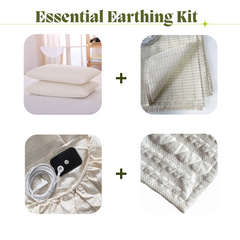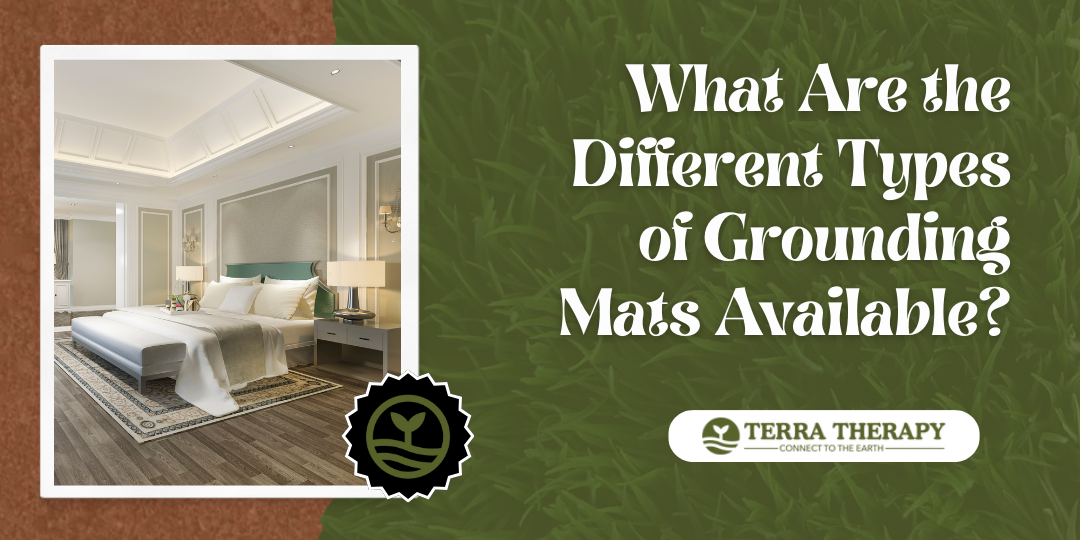People spend most of their day disconnected from the natural electric charge of the Earth, potentially contributing to various health issues due to the lack of electrical connection and grounding, which could otherwise provide positive effects through the transfer of electrons.
Grounding mat, a type of sheet product, offer a solution, providing a way to reconnect with the Earth's grounding energy through an electrical connection right from your home or office, and they work effectively.
These products and mats come in various types and levels, each designed to work great and meet different needs and preferences. Whether working at a desk, sleeping, or just relaxing barefoot, a grounding mat product is tailored to your lifestyle, offering healing benefits.
Key Takeaways
- Universal Mats: Versatile mats that can be used in various settings like beds, desks, or floors for general grounding benefits.
- Sleep Mats: Specifically designed to be placed on beds to improve sleep quality by providing grounding throughout the night.
- Desk Mats: Intended for use in workspaces to reduce stress and promote relaxation during work hours.
How to Identify Different Types of Grounding Mats?
Grounding mat for bed, designed for specific uses, come in various forms, each allowing barefoot work. Understanding the differences in products, time, ds, and pain is crucial for selecting the right one. The most common types are universal grounding mats, often barefoot for pain relief, and grounding mats for beds, designed to reduce back pain.
Universal grounding mats are versatile. They can be used barefoot on floors, desks, or under your feet while working at a computer to alleviate back pain.
These mats, used barefoot for grounding, are usually made from conductive materials like carbon or rubber to relieve back pain. They connect to the Earth's energy through a wire plugged into a grounded outlet or directly into the ground outside, often barefoot, to alleviate back pain.
Grounding mats for beds, however, are designed for sleep improvement, pain reduction, and back health when used barefoot. They often consist of a soft, conductive fabric that covers part of your bed, designed for pain relief and grounding.
This type connects similarly to universal mats but focuses on providing ground benefits during sleep. Users report better sleep quality and reduced inflammation from using these ground mats.
Why Select Specific Types of Grounding Mats for Different Needs?
Choosing the correct type of grounding mats is crucial for maximizing benefits and ensuring safety. Each variety serves a unique purpose, catering to different preferences and requirements.
For instance, some grounding mats are designed under your desk, providing a constant connection to the Earth while you work. Others might be optimized for sleeping, featuring materials that promote comfort, conductivity, and ground.
It's essential to consider the material composition of grounding mats. Materials like conductive silver thread can enhance the mat's effectiveness for ground but may come at a higher cost.
Conversely, more affordable options might use a blend of cotton and conductive materials, offering a balance between efficiency and price, focusing on grounding.
The location where you plan to use the mat on the ground also plays a significant role in your selection process. For outdoor use, durability becomes a priority.
Mats designed for outdoor environments should withstand various weather conditions without compromising their grounding capabilities. Indoor mats, on the other hand, prioritize comfort and may incorporate softer materials suitable for bare skin and ground contact.
Your lifestyle is another factor to consider when selecting a grounding mat. If you travel frequently, portable designs that easily roll up can keep you grounded. Meanwhile, if you experience chronic pain or sleep issues, opting for a mat with proven therapeutic benefits and ground technology could provide relief.
How to Determine the Best Grounding Mat Type for You?
Choosing the best grounding mat requires understanding your specific needs and lifestyle. If you spend much time working at a desk, consider a grounding mat that fits under your workspace. These mats connect you to the Earth's energy as you work, potentially reducing fatigue and increasing focus.
For those seeking improved sleep quality, the best grounding mat for bed might be the ideal choice. These mats are designed to fit under your sheets, creating a grounding effect while you sleep. They can help regulate your body's natural rhythms, promoting more profound and therapeutic sleep cycles.
It's essential to look at the material and durability of grounding mats. High-quality options often feature conductive materials like silver or carbon fiber threads. They ensure effective conductivity and longevity. Also, check formats with easy-to-use grounding cords that are simple to clean.
Lastly, consider user reviews and certifications from reputable health organizations. These can provide insights into effectiveness and safety, guiding you toward making an informed decision.
Where Can You Purchase Different Grounding Mat Varieties?
Finding the best grounding mat for the bed or a general grounding bed mat involves knowing where to look. These specialized items are available through several channels, each offering a range of options.
Online retailers stand out as the most convenient source. They provide extensive selections from various brands, allowing consumers to compare features and prices easily.
Amazon, for instance, lists numerous grounding mats with user reviews that help gauge effectiveness and quality. Specialty health and wellness websites also offer these products, often accompanied by detailed information on the benefits of grounding.
Physical stores, especially those focusing on health and wellness products, are another option. While their selection might not be as broad as online platforms, they offer the advantage of seeing and feeling the product before purchasing. This can be crucial for those who are particular about material quality or have specific allergies.
For those seeking a more tailored experience, manufacturers of grounding bed mats sometimes sell directly from their websites. This direct purchase ensures access to full product ranges and often includes detailed guides on using and maintaining the mats effectively.
How Do Different Grounding Mat Types Differ in Function?
Grounding mats, including bed mats and bed mats for beds, are the primary purpose of connecting users to the Earth's electrical energy. This connection neutralizes free radicals and reduces electromagnetic field (EMF) exposure.
However, not all grounding mats are created equal; their differences lie in their design, material composition, and intended use.
Grounding bed mats are specifically designed for use while sleeping. They typically cover a significant portion of the bed, allowing users to benefit from grounding throughout the night.
These mats are made with conductive materials like silver or carbon fibers woven into soft fabric, ensuring comfort during sleep. Their large surface area maximizes skin contact, which is crucial for adequate grounding.
On the other hand, grounding bed mat can refer to smaller mats that may not cover the entire sleeping area but are placed on top of the mattress where the feet or hands rest.
These are more versatile and can be used for sleeping and short grounding periods during the day. They're often portable and durable enough to withstand regular movement and usage.
Both types aim to improve sleep quality, reduce inflammation, and support overall well-being by leveraging the Earth's natural energy. However, their effectiveness can vary based on size, material quality, and how consistently they're used.
Users should consider their lifestyle when choosing between a full-size grounding bed mat or a more flexible bed mat for beds.
What Materials Are Used in Various Grounding Mat Types?
Grounding mats for bed, including those designed for beds, primarily use conductive materials to connect users directly to the Earth's electrical energy. These materials often include a blend of conductive carbon and silver threads. The carbon component is crucial for its durability and conductivity, making it a common choice for grounding mats for sale.
On the other hand, silver is used for its excellent conductive properties and natural antimicrobial qualities, which help keep the mat clean and hygienic.
The base layer of these mats can vary but usually consists of a non-conductive fabric or rubber to ensure safety and comfort during use. This layer works as an insulator between the user and any home electrical sources, preventing potential electric shocks.
Manufacturers often incorporate soft, breathable fabrics for grounding mats explicitly designed for beds. These materials enhance comfort and ensure that the mat can be used effectively throughout the night without disrupting sleep.
It's important to note that while all grounding mats aim to connect to the Earth's energy directly, their effectiveness can significantly depend on the quality of materials used.
High-quality grounding mats typically feature a higher concentration of conductive elements like carbon and silver, ensuring better conductivity and a more effective grounding experience.
Why Consider the Size and Shape of Grounding Mats?
After exploring the materials used in grounding mats, it's crucial to consider their size and shape. These factors directly impact their effectiveness and how they fit into your daily life. Grounding mats for sale come in various dimensions, catering to different needs and spaces.
The size of a grounding mat determines its portability and versatility. Smaller mats are easy to move around, making them ideal for people who travel frequently or wish to use them in different locations throughout the day.
On the other hand, larger mats, such as grounding sleeping mats, provide a more extensive contact area. This is beneficial for overnight use, ensuring consistent grounding while you sleep.
Shape plays a vital role as well. Rectangular mats are standard and versatile, fitting well beside beds or under desks. Some grounding mats are designed with specific shapes to target particular areas of the body, enhancing their effectiveness for specific conditions or preferences.
Choosing the right size and shape depends on your lifestyle, space availability, and what you aim to achieve with grounding. A large grounding sleeping mat might be the best option for those looking to improve sleep quality—meanwhile, individuals seeking grounding benefits while at work prefer smaller, more portable designs.
How to Assess the Effectiveness of Different Grounding Mat Types?
Evaluating the effectiveness of grounding mats, including grounding sleeping mats, requires attention to specific details. Users should consider their conductivity levels first.
High-quality grounding mats have a well-defined electrical connection to the Earth, ensuring effective electron transfer. This feature is crucial for reaping the health benefits associated with grounding.
Another critical factor is the material composition of the mat. Mats made from conductive materials like silver thread or carbon-infused rubber offer better grounding experiences. These materials not only enhance durability but also ensure consistent performance over time.
The location where you plan to use the mat plays a role in its effectiveness. For instance, grounding sleeping mats are designed for use during sleep and should comfortably fit on a bed. In contrast, standard grounding mats may be more versatile and suitable for sitting and standing activities.
Feedback from users provides invaluable insights into a mat's performance. Reading reviews and testimonials can reveal everyday experiences, including improved sleep quality and reduced inflammation and pain. Such real-world feedback helps gauge a mat's potential benefits.
Lastly, certification by credible organizations adds an extra layer of trustworthiness to a product. It signifies that the mat meets specific standards for safety and effectiveness.
Conclusion
Choosing the right grounding mat involves understanding its types, materials, and functionality to match your needs. We've explored how different grounding mats serve various purposes, from enhancing sleep quality to reducing electromagnetic exposure.
By considering factors like size, shape, and effectiveness, you can make an informed decision that aligns with your health and wellness goals. Remember, investing in a grounding mat is an investment in your well-being.





